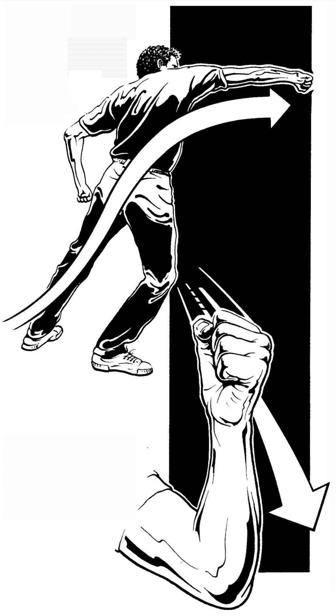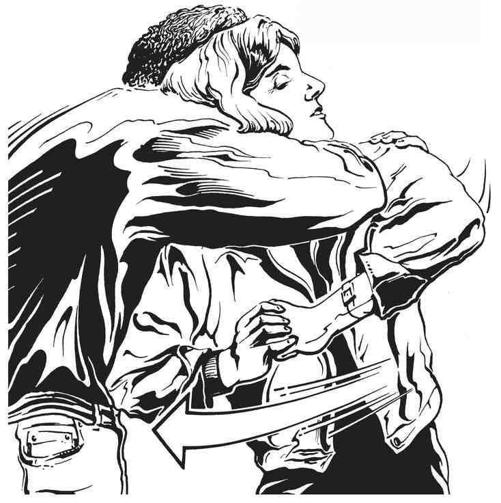SAS Urban Survival Handbook (97 page)
Read SAS Urban Survival Handbook Online
Authors: John Wiseman
Tags: #Health & Fitness, #Reference, #Survival, #Fiction, #Safety, #Self-Help, #Personal & Practical Guides, #General, #Survival Skills


STOMACH
A large soft area, which is low enough to be attacked by the knee. Trained people keep their stomachs firm, but the majority of people have no muscle tone at all. If punched or kicked, the attacker may be ‘winded’ and temporarily incapacitated.
SOLAR PLEXUS
At the top of the stomach in the arch made by the ribs is a particularly sensitive area. Punching here will not hurt your hands—but the attacker may be doubled up.
GROIN
The lower abdomen is sensitive, but perhaps most sensitive are a man’s testicles. A well-aimed kick or knee will hurt either sex, but a man may be quite literally brought to his knees by the pain. Grab, twist or pull the testicles. Strike them with a fist, knee or foot.
KNEE
The knee joint is very delicate. A well-aimed downward kick might totally immobilize your attacker. A blow to the inside of the knee (between the legs) is very painful. If you miss, scraping a hard shoe down the front of the shin should also do the trick.
KIDNEYS
From behind, any blow in the region of the kidneys is usually effective. It can cause great pain and breathlessness.
There are many other vulnerable parts of the body which can make suitable targets in your defence. All the joints are vulnerable—any hold which puts strain on one or more is disabling. Fingers can be bent, wrists twisted and elbows locked. If you find any of the nerve points on the body, they can cause a great deal of discomfort. Use them to effect release from an attacker.
NATURAL WEAPONS
Now that you know the targets, you need to learn how to use your natural weapons. The legs are the longest, so they can be used to make attackers keep their distance. The hands are the fastest weapons, but have the disadvantage of being easily damaged.

WARNING
Most people instinctively punch when threatened, but this is not a good technique. If your hand strikes the attacker’s head, you could break a bone in a finger. If you hit their teeth, you may cut your hand and get quite a nasty infection. Your hands can swell up very quickly and become unusable. Even boxers, who know how to use their hands, are VERY careful about them. They make sure their hands are protected before a contest. PUNCHING IS FOR SOFT
TARGETS ONLY.
PUNCH
To punch correctly, you must make a proper fist. Look at your hand, palm up. Starting with the little finger, curl in the fingers one by one, locking the thumb OVER the fingers.
NEVER
curl the fingers over the thumb.
NEVER
let your little finger stick out. If you make a fist incorrectly, you will hurt yourself more than the person you are hitting.

The wrist
MUST
be locked, or you may damage it. The line of the forearm should follow straight to the knuckles.
A punch should use the whole body—it should come from the legs, through the waist, through the shoulder and finally through the arm. All the power comes from the legs and the torque effect of the waist. DON’T draw back to punch—it’s too slow, it announces the strike and it’s easy to block an expected punch.

HAMMER FIST
The best way to use your fist! Make a fist as before (see
Punch
). Use it as a hammer wherever you can. Aim for the attacker’s nose, ear—almost any target. You’ll find you can deliver quite a blow.

PALM STRIKE
If you were told to punch a wall, you wouldn’t use a lot of force—it would hurt. If you hit the wall with a palm strike or hammer fist you can use quite a lot of force without damaging yourself. The palm strike can be very effective.
Cock your wrist—angle the hand back slightly on the wrist. Spread the fingers and curl them tightly, holding the thumb in to avoid damaging it.
Use the heel of the hand or the bottom of the palm to strike the attacker’s jaw from below. Keeping the movement close to the attacker’s body means they may not see it coming. If you miss the jaw you will probably hit the nose, which would have been your next target.
When you hove hit the jaw in this way, your fingers can easily find the eyes.

PALM EDGE
The palm edge can be useful for attacking the throat or the back of the neck, although it may not work as well as it does in the movies!
FINGERS
Use these to attack the face and eyes. They can be flicked out with a minimum of effort and used to gouge. Use them as claws. Open your fingers slightly from the palm, strike and scratch. Use a ′swinging′ movement like a cat or dig in and drag.
Make the fingers into a chisel point, keeping the thumb tucked safely in, and jab at the philtrum (the upper lip just below the nose), the throat or the eyes.

FOREARM
The forearm is a hard bony structure and is useful for a ′back hander′ to your opponent’s face or neck. The attacker may think you are turning away. When you lash out with a backswing, they are caught off guard. Almost anything that is banned in boxing is good for defence!

ELBOW
The elbow is one of your best weapons. It delivers a considerable blow—often with maximum power and maximum surprise. Snap it up under the jaw or nose. Use it if your attacker is in front, to one side or behind you. Disguise the twist of your body as an attempt to get free and bring the elbow back for all you are worth across the face or under the jaw.
Extra force is added if you make a fist of your hand, cup the other hand round it and literally push the elbow into the attacker’s stomach.
